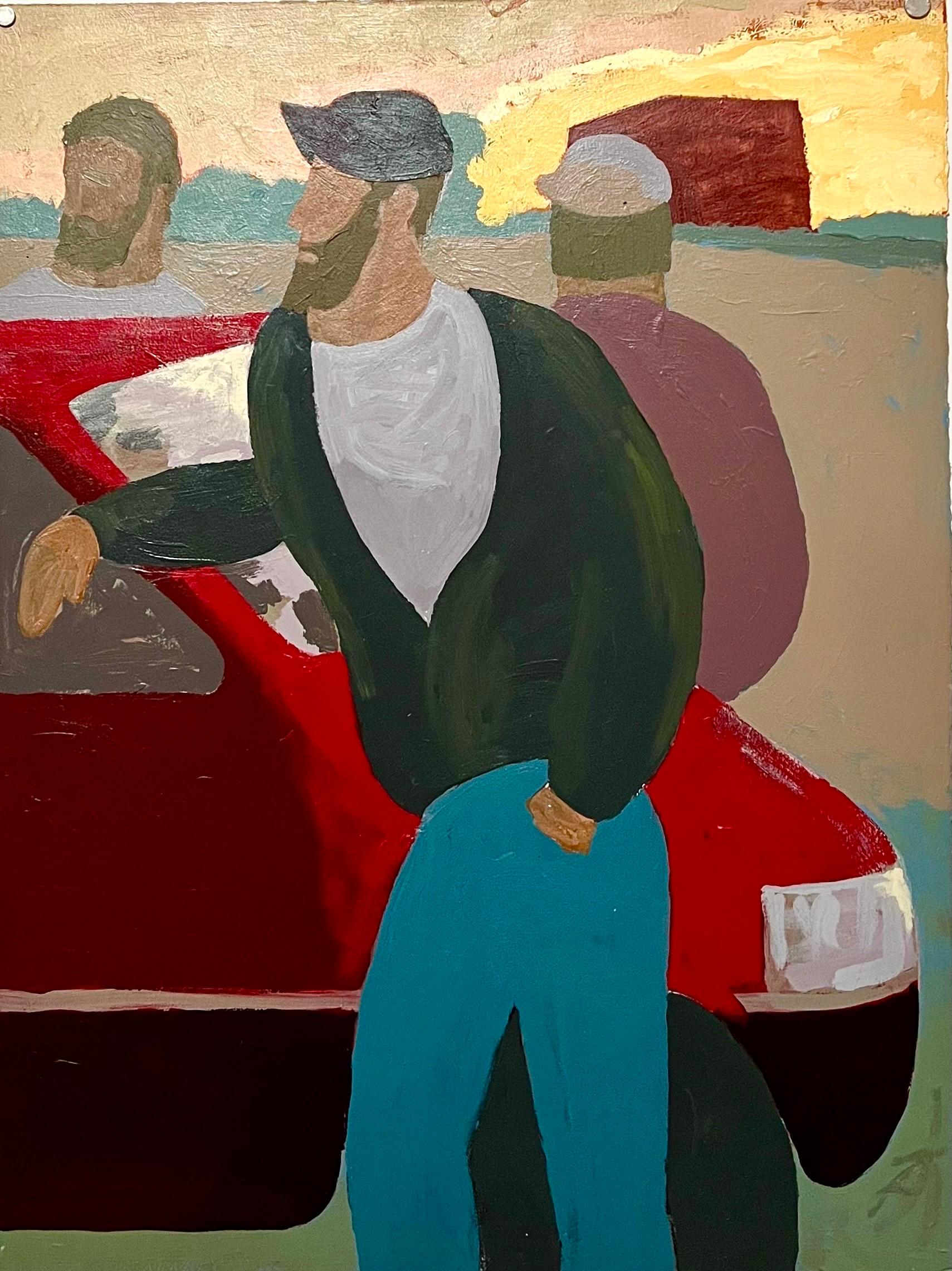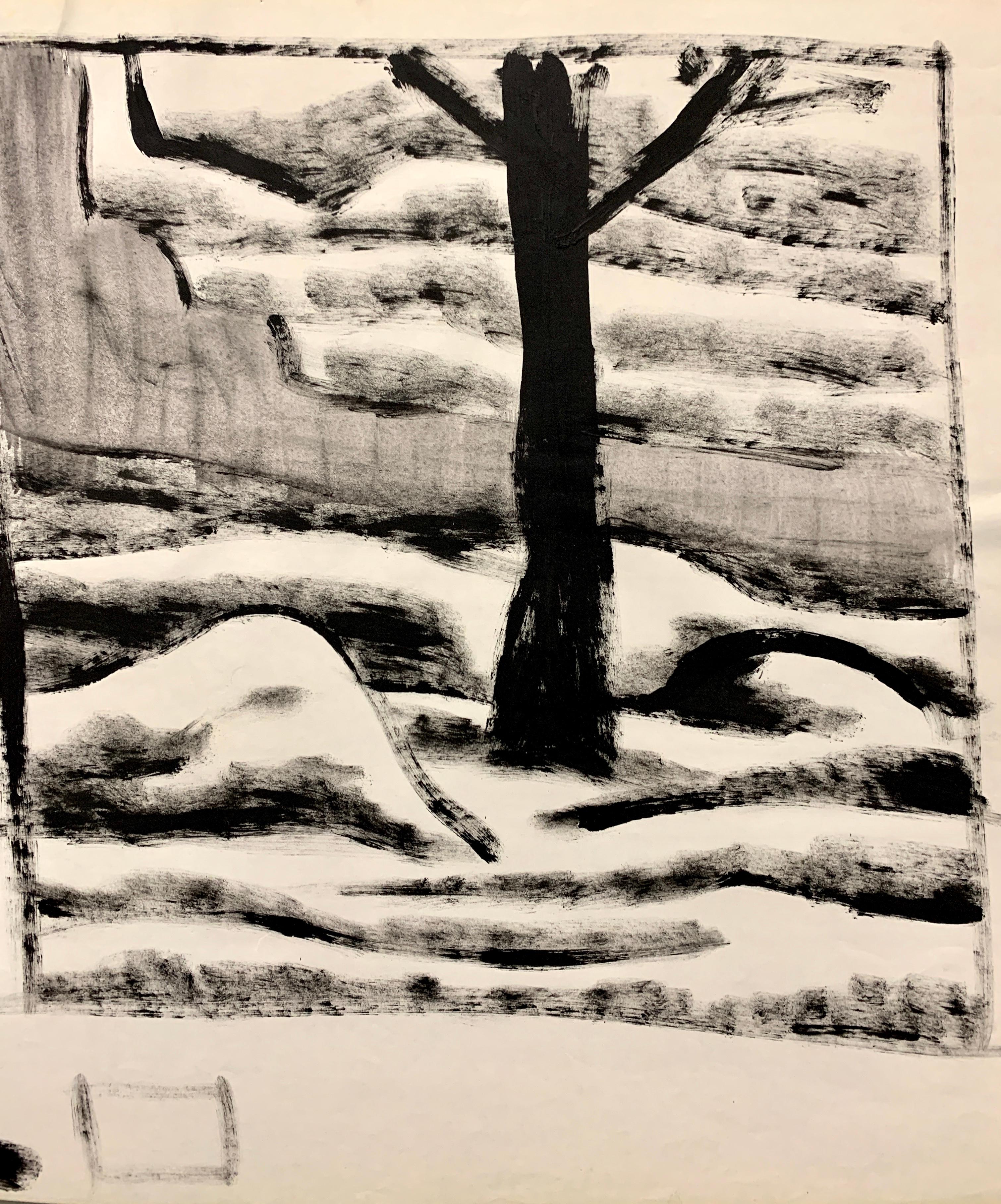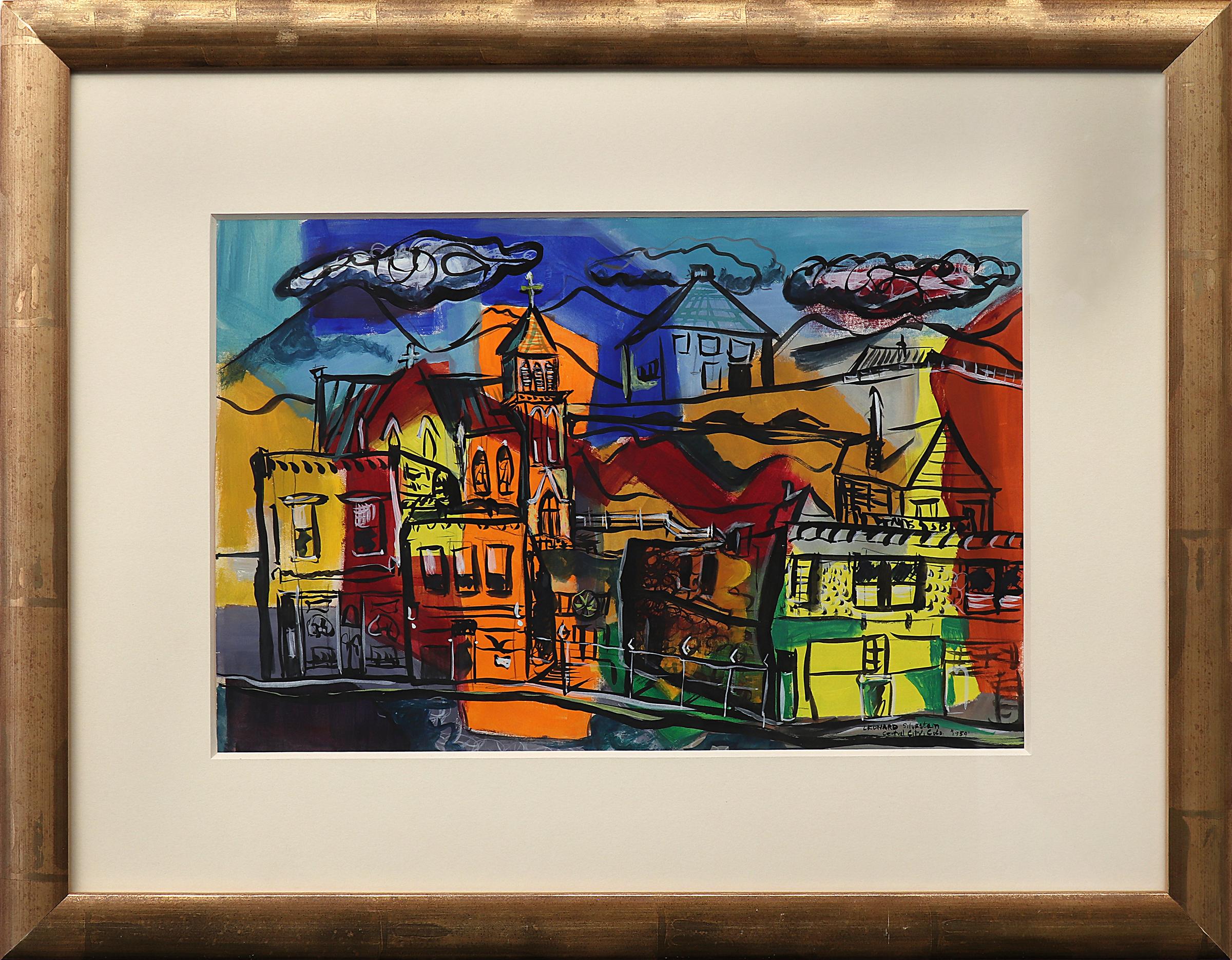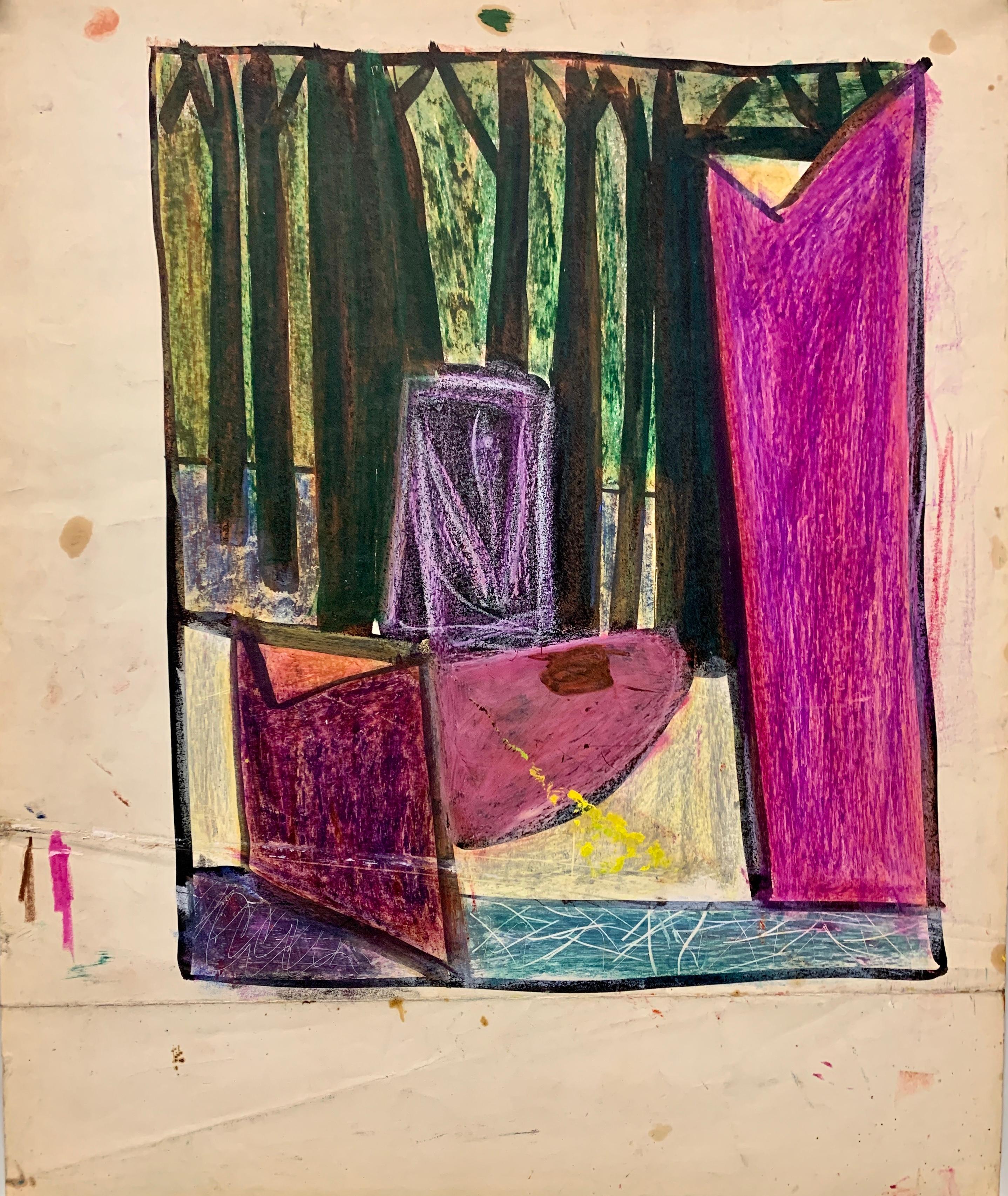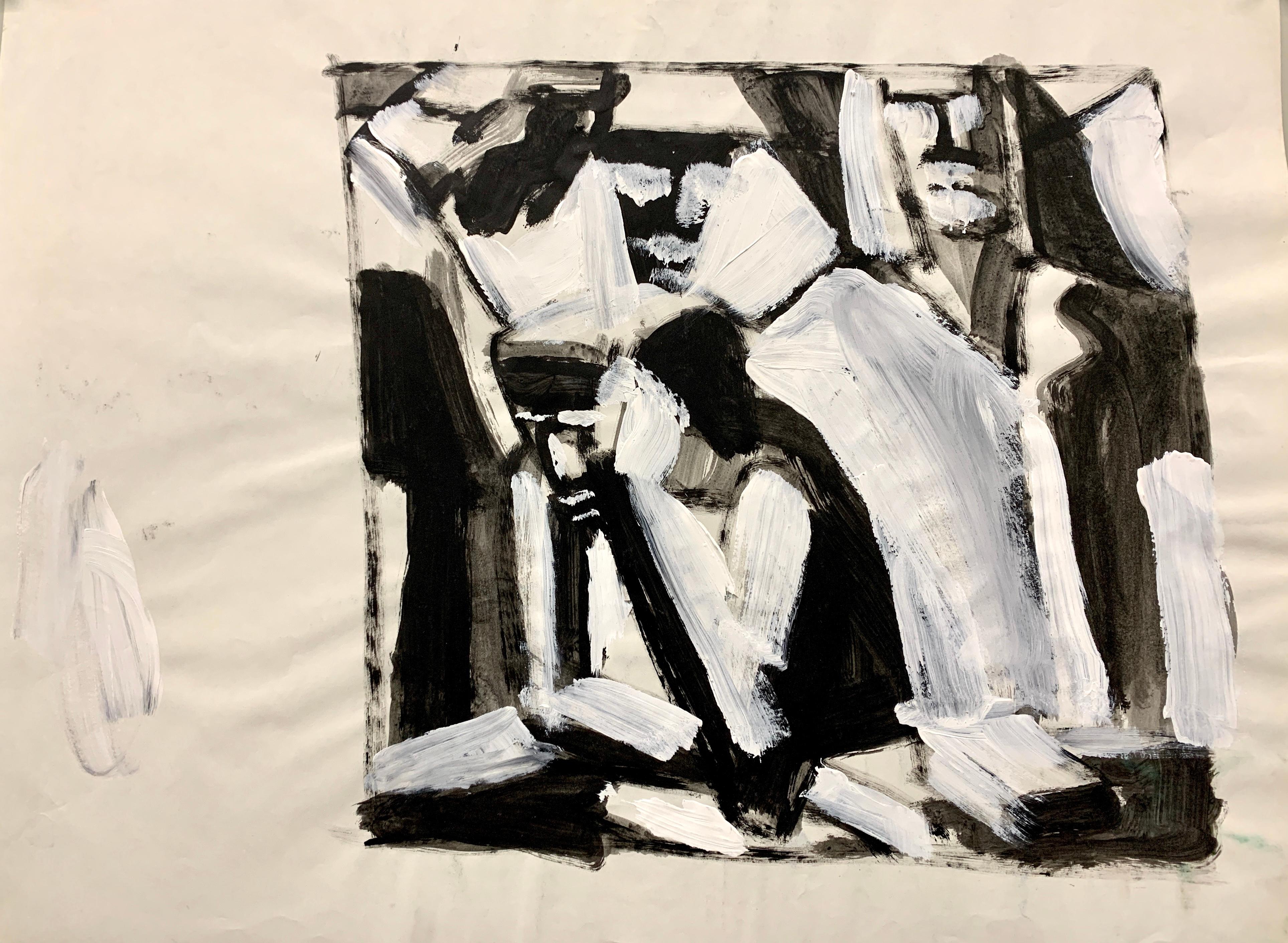Items Similar to Untitled [Abstraction]
Want more images or videos?
Request additional images or videos from the seller
1 of 8
George L.K. MorrisUntitled [Abstraction]c. late 1940s
c. late 1940s
About the Item
Gouache on paper, 18 7/8 x 14 3/4 in.
Signed (at lower right): Morris; (with monogram, on the back): GLKM [monogram] / 1932 [sic]
Executed circa late 1940s
A passionate advocate of abstract art during the 1930s and 1940s, George L. K. Morris was active as a painter, sculptor, editor, and critic. An erudite man with an internationalist point of view, Morris
eschewed the social, political, and figural concerns that preoccupied so many artists of Depression-era America, believing that painters should focus their attention on the beauty, refinement, and simplicity of pure form instead. His goal, he said, was “to wedge the expression further and further into the confines of the canvas until every shape takes on a spatial meaning” (as quoted in Ward Jackson, “George L. K. Morris: Forty Years of Abstract Art,” Art Journal 32 [Winter 1972–73], p. 150).
Born into an affluent family in New York City, Morris was a descendent of General Lewis Morris, a
signer of the Declaration of Independence. From 1918 until 1924, he attended the Groton School in
Connecticut, studying classics and art. He continued to focus on literature and art while attending
Yale University (1924–28), an experience that prepared him well for his future activity as an artist-critic. After graduating in 1928, Morris studied at the Art Students League of New York, working
under the realist painters John Sloan and Kenneth Hayes Miller, as well as Jan Matulka, the only
modernist on the faculty. In the spring of 1929, Morris traveled to Paris with Albert E. Gallatin, a
family friend and fellow painter who introduced him to leading members of the Parisian avant-garde, including Jean Arp, Pablo Picasso, Georges Braque, Jean Hélion, and Piet Mondrian. Morris also took classes at the Académie Moderne, studying under Fernand Léger and Amédée Ozenfant, important exponents of Synthetic Cubism who influenced his aesthetic development. Indeed, after experimenting with the simplified forms of Modernism for a few years, Morris moved on to abstraction by 1934, adopting a hard-edged, geometric approach inspired by Leger’s cubist style and the biomorphic shapes of Arp and Joan Miró.
Following his return to New York in 1930, Morris built a white-walled, open-spaced studio (inspired
by that of Ozenfant, which had been designed by Le Corbusier) on the grounds of Brockhurst, his
parents’ 46-acre estate in Lenox, Massachusetts. In 1935, he married the painter and collagist Estelle “Suzy” Frelinghuysen (1911–1988), who shared his penchant for abstraction. One year later, the couple helped found American Abstract Artists, a group of forward-thinking artists dedicated to promoting geometric abstraction in the United States.
Untitled features a tight, mosaic-like network of squares (some plain, others embedded with circles) contained within carefully delineated contours set against a backdrop of radiating color planes that converge on the segmented disc that serves as the focal point of the composition. (The evolution of Morris’s style, as he moved from a tentative modernist aesthetic to the type of geometric abstraction exemplified in Untitled is apparent upon perusal of the verso of the sheet, which features a watercolor study from 1932. The summarily rendered shapes suggest the influence of Henri Matisse, who Morris had met in New York in 1931, while the fragmented lines point to his growing penchant for Cubism. Despite the high degree of stylization, however, the site can easily be identified as the Pulitzer Fountain in Manhattan’s Grand Army Plaza [at the southeast entrance to Central Park across from the Plaza Hotel], a well-known landmark crowned by Karl Bitter’s allegorical bronze sculpture, Pomona, the Roman goddess of abundance [erected 1916].) By altering the sizes of the patches and juxtaposing solid areas of color (blue, black, and white) with subtle greys, tans, and pale pinks, Morris creates a tunnel-like sense of depth while retaining the tension and structural integrity of the two-dimensional picture plane. The artist’s kaleidoscope-like arrangement of planar forms readily brings to mind the words of the critic Frank Getlein, who described the effect as being “somewhat similar to that of looking down the well of a staircase” (Frank Getlein, “Knaths and Morris in Washington,” The New Republic 152 [May 15, 1965], n.p.).
In 1941, Morris and Freylinghusen added a streamlined, Bauhaus-inspired residence (designed by
John Butler Swann) on to their Lenox studio, selling one of their Picassos to underwrite the cost.
(Decorated with their own frescoes, modernist furniture, and their extensive collection of abstract art, the Frelinghuysen Morris House & Studio is listed on the National Register of Historic Places and has been open to the public since 1998.) After his solo debut at the Valentine Gallery in New York in 1933, Morris went on to exhibit his work in other leading commercial establishments, among them Edith Halpert’s legendary Downtown Gallery, the Reinhardt Galleries, the Alan Gallery, and Hirschl & Adler Galleries, as well as at venues abroad, including Galerie Pierre and Galerie Colette Allendy in Paris and the Mayor Gallery in London. He also had one-man shows at the Berkshire Museum in 1933 and 1966 and at Yale University in 1935. Morris likewise participated in the annual exhibitions at the National Academy of Design, the Whitney Museum of American Art, the Pennsylvania Academy of the Fine Arts, the Carnegie Institute, and the Art Institute of Chicago. He continued to exhibit his work into the early 1970s, winning the National Academy’s Saltus Gold Medal in 1973. Morris died on June 26, 1975, following an automobile accident near Stockbridge, Massachusetts.
- Creator:George L.K. Morris (1905-1975, American)
- Creation Year:c. late 1940s
- Dimensions:Height: 18.88 in (47.96 cm)Width: 14.75 in (37.47 cm)
- Medium:
- Movement & Style:
- Period:
- Condition:
- Gallery Location:New York, NY
- Reference Number:
About the Seller
5.0
Recognized Seller
These prestigious sellers are industry leaders and represent the highest echelon for item quality and design.
Established in 1952
1stDibs seller since 2010
32 sales on 1stDibs
Typical response time: 7 hours
Associations
Art Dealers Association of America
- ShippingRetrieving quote...Ships From: New York, NY
- Return PolicyThis item cannot be returned.
More From This SellerView All
- Yours TrulyBy Arthur DoveLocated in New York, NYYours Truly is a work of 1927, a fertile year for Dove, capped by a solo exhibit at Stieglitz’s “The Intimate Gallery,” which included this picture. From 1924 through 1930, Dove produced a notable series of collages, interspersed with drawings, pastels, and oil paintings on a variety of supports. In 1927, the same year that Dove painted Yours Truly, he found inspiration in American popular music, often referring in his titles to works by George Gershwin and Irving Berlin. Yours Truly was the title of a Broadway musical that opened at the Shubert Theater on January 25, 1927. Gene Buck, the producer, had collaborated with Raymond Hubbell, the composer, on the Ziegfield Follies shows of 1923, 1924, and 1925. The production, which contained the title song, “Yours Truly,” ran for 127 performances, closing on May 14, 1927. Given the context of Dove paintings...Category
1920s American Modern Paintings
MaterialsOil, Canvas
- UntitledBy Louisa ChaseLocated in New York, NYLouisa Lizbeth Chase was born in 1951 to Benjamin and Wilda Stengel Chase in Panama City, Panama, where her father, a West Point graduate, was stationed. The family moved to Pennsylv...Category
20th Century American Modern Abstract Paintings
MaterialsCanvas, Oil
- Nowhere, Now HereBy Louisa ChaseLocated in New York, NYLouisa Lizbeth Chase was born in 1951 to Benjamin and Wilda Stengel Chase in Panama City, Panama, where her father, a West Point graduate, was stationed. The family moved to Pennsylv...Category
1980s American Modern Abstract Paintings
MaterialsCanvas, Wax, Oil
- UntitledBy Louisa ChaseLocated in New York, NYLouisa Lizbeth Chase was born in 1951 to Benjamin and Wilda Stengel Chase in Panama City, Panama, where her father, a West Point graduate, was stationed. The family moved to Pennsylv...Category
Late 20th Century American Modern Abstract Paintings
MaterialsOil, Canvas
- HugBy Louisa ChaseLocated in New York, NYLouisa Lizbeth Chase was born in 1951 to Benjamin and Wilda Stengel Chase in Panama City, Panama, where her father, a West Point graduate, was stationed. The family moved to Pennsylv...Category
20th Century American Modern Abstract Paintings
MaterialsCanvas, Oil
- ExcavationBy Charles Houghton HowardLocated in New York, NYCharles Houghton Howard was born in Montclair, New Jersey, the third of five children in a cultured and educated family with roots going back to the Massachusetts Bay colony. His fat...Category
20th Century American Modern Abstract Paintings
MaterialsCanvas, Oil
You May Also Like
- Large Hudson River Figurative Modernist Landscape Oil Painting Edward AvedisianBy Edward AvedisianLocated in Surfside, FLEdward Avedisian ( 1936-2007 ) Gouache or oil on paper, 3 guys around a car, hand signed in paint lower left, Measures 30"x 22.5" Edward Avedisian (June 15, 1936, Lowell, Massachusetts – August 17, 2007, Philmont, New York) was an American abstract painter who came into prominence during the 1960s. His work was initially associated with Color field painting and in the late 1960s with Lyrical Abstraction and Abstract Expressionism. He studied art at the School of the Museum of Fine Arts, Boston. By the late 1950s he moved to New York City. Between 1958 and 1963 Avedisian had six solo shows in New York. In 1958 he initially showed at the Hansa Gallery, then he had three shows at the Tibor de Nagy Gallery and in 1962 and 1963 at the Robert Elkon Gallery. He continued to show at the Robert Elkon Gallery almost every year until 1975. During the 1960s his work was broadly visible in the contemporary art world. He joined the dynamic art scene in Greenwich Village, frequenting the Cedar Tavern on Tenth Street, associating with the critic Clement Greenberg, and joining a new generation of abstract artists, such as Darby Bannard, Kenneth Noland, Jules Olitski, and Larry Poons. Avedisian was among the leading figures to emerge in the New York art world during the 1960s. An artist who mixed the hot colors of Pop Art with the cool, more analytical qualities of Color Field painting, he was instrumental in the exploration of new abstract methods to examine the primacy of optical experience. One of his paintings was appeared on the cover of Artforum, in 1969, his work was included in the 1965 Op Art The Responsive Eye exhibition at the Museum of Modern Art and in four annuals at the Whitney Museum of American Art. His paintings were widely sought after by collectors and acquired by major museums in New York and elsewhere. He has been exhibited in prominent galleries, such as the Anita Shapolsky Gallery and the Berry Campbell Gallery in New York City. Edward Avedisian was known for his brightly colored, boldly composed canvases that combined Minimalism's rigor, Pop art exuberance and the saturated tones of Color Field painting. Roberta Smith of the NYT writes of Avedesian: "Edward Avedisian helped establish the hotly colored, but emotionally cool, abstract painting that succeeded Abstract Expressionism in the early 1960s. This young luminary harnessed elements of minimalism, pop, and color field painting to create prominent works of epic proportions that energized the New York art scene of the time." In 1996 Avedisian showed his paintings from the 1960s at the Mitchell Algus Gallery, then in SoHo. His last show, dominated by recent landscapes, was in 2003 at the Algus gallery, now in Chelsea. Selected Exhibitions: Op Art: The Responsive Eye, at the Museum of Modern Art, Whitney Museum’s Young America 1965 Expo 67, held in Montreal, Canada. Six Painters (along with Darby Bannard, Dan Christensen, Ron Davis...Category
20th Century American Modern Landscape Paintings
MaterialsOil, Gouache, Archival Paper
- Mid Century Fruit Still Life Gouache Painting Bay Area ArtistLocated in Arp, TXFrom the estate of Jerry Opper and Ruth Opper Fruit Still Life c. 1950's Gouache on Paper 12" x 18", tiger maple wood frame 18.5"x1"x22.25" unsigned Early ...Category
Mid-20th Century American Modern Still-life Paintings
MaterialsPaper, Gouache
- 1950s "Mound Street" Mid Century Figurative Painting American ModernistBy Donald StacyLocated in Arp, TXDonald Stacy "Mound Street" c. 1950s Gouache paint on paper 24" x 18'" unframed Unsigned Came from artist's estate For sale is a striking black and white painting titled "Mound Stre...Category
Mid-20th Century American Modern Abstract Paintings
MaterialsPaper, Gouache
- Central City, Colorado, 1950s Semi-Abstract Cityscape Gouache Painting, Red BlueLocated in Denver, CO'Central City, Colorado' by Leonard Silverstein is an original gouache on paper from 1954. Hand signed, titled, and dated by the artist in the lower right...Category
1950s American Modern Landscape Paintings
MaterialsGouache, Archival Paper
- 1950s "Group Meeting" Mid Century Figurative Gouache University of ParisBy Donald StacyLocated in Arp, TXDonald Stacy "Group Meeting" c.1950s Gouache paint on paper 24" x 18'" unframed Unsigned Came from artist's estate Donald Stacy (1925-2011) New Jersey Studied: Newark School of Fin...Category
Mid-20th Century American Modern Figurative Paintings
MaterialsPaper, Gouache
- 1950s "Forest Through Window" MidCentury Abstract Gouache University of ParisBy Donald StacyLocated in Arp, TXDonald Stacy "Forest Through the Window" c.1950s Oil pastel and gouache paint on paper 14" x 17" unframed Unsigned Came from artist's estate Donald Stacy (1925-2011) New Jersey Studied: Newark School of Fine Art The Art Students League Pratt Graphic Arts Center University of Paris 1953-54 University of Aix-en-Provence 1954-55 Faculty: Art Department of the New School Museum of Modern Art School of Visual Arts Stacy Studio Workshop Exhibitions: Grand Central Moderns George Wittenborn The New School Print Exhibitions, Chicago University of Oklahoma Honolulu Museum Monclair Museum Wisconsin State College Louisiana Art...Category
Mid-20th Century American Modern Abstract Paintings
MaterialsPaper, Gouache, Oil Pastel
Recently Viewed
View AllMore Ways To Browse
Modern Abstraction
Vintage Art Journal
Chicago Artists Abstraction
L Pink Art
George Whitney
George Washington Paintings
Vintage Valentines Art
1940s Avant Garde
C Morris
Miro L
Picasso Gouache
Picasso Untitled
Grand Army
George K
George Washington Figure
American Gold Picture Frame
Depression Era Art
Solid Square Painting
